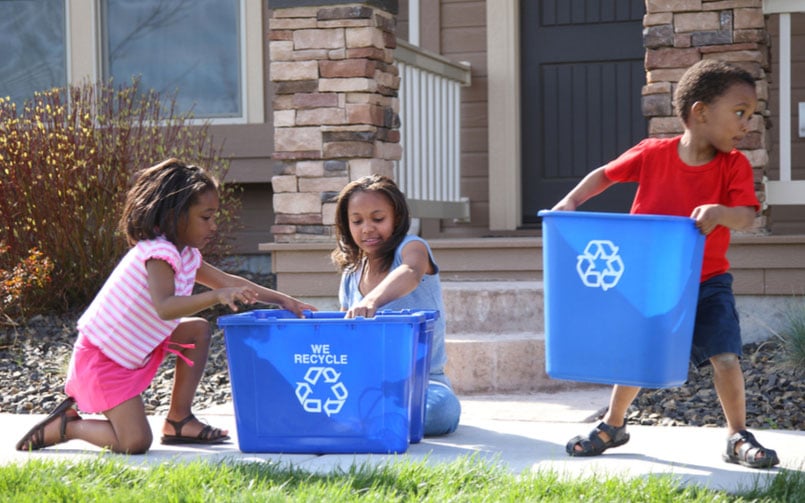Did you know adding something as simple as self-watering planters to your landscape design can reduce how much water you use, lighten the load on the environment, and save you time? It’s true!
Our uniquely designed self-watering attachments fit inside any of our planters, creating a separate chamber for excess water to collect. As a result, plant roots aren’t left to soak in water—an occurrence that commonly leads to root rot and other issues. Designed with water-wicking technology, the water is drawn back up into the plant soil as needed. Therefore, plants are at a reduced risk of drying out and being overwatered. Plus, you’ll enjoy reduced maintenance.
3 Ways Self-Watering Planters Make Your Landscape Greener
#1. Enjoy Happier & Healthier Plants
Happy and healthy plants are greener by nature! Self-watering planters help plants better thrive by providing a more ideal environment with consistent access to water.
#2. Waste Less Water
Sure, you could drill a hole at the bottom of the planter so excess water flows out. This will help prevent root rot, but it also wastes precious water. Self-watering planters reuse excess water, making the most out of every drop.
#3. Save Time & Money
Keep more green in your pocket thanks to less money spent on maintaining and watering plants. Going out of town for the week? Your self-watering planters can take care of the watering duties—no need to waste your money paying someone to water your plants. Plus, since self-watering planters help conserve water, you may even see your water bill go down.
6 More Green Landscaping Ideas
The following green landscaping ideas will make your property pop without breaking the bank or harming the environment—what more could you ask for?
#1. Take Note of the Materials You Purchase
From light posts to planters, take time to notice what materials different landscaping elements are made from. Be on the lookout for:
- Landscaping accessories, such as planters and furnishings, that are made from recycled materials
- Products made in the USA using sustainable practices
- Long lasting materials so you don’t have to waste money replacing them all the time
Looking to go green and save money? Learn more about our resin-based material. Did we mention most of our products qualify for LEED credits and points?
#2. Use Native Plants
Native plants can naturally survive in your area without extra help from you—that means they require less water and overall maintenance. Not to mention, they are designed to withstand local bugs, which means you can avoid pesticides that are costly and bad for the environment. In fact, chemical fertilizers are considered one of the “big three” in terms of the main environmental pollutants associated with landscaping. Also, native plants do better in local soil, yet another thing you won’t have to worry about substituting.
#3. Add Recycling Bins
Add separate trash and recycling receptacles to promote recycling. This is especially important for commercial or public locations that attract a lot of traffic. Recycling is key, and you can help play a role in more people recycling by simply adding clearly marked recycling bins around your property.
#4. Use LED lighting
LED lighting fixtures use a fraction of the energy traditional bulbs utilize. Not to mention, they last a lot longer before burning out and needing to be replaced.
Shop our long-lasting LED fixtures
#5. Go for the Faux Grass
Astroturf is back and more desirable than ever. The latest versions look like real grass and can last a lot longer than you might think with little to no maintenance. You won’t have to water it or mow it—two activities that take up time and precious resources.
Can’t stay away from real green grass? Consider investing in automatic irrigation systems to reduce waste. Plus, irrigation systems encourage plant life to form stronger and deeper roots.
Another option is to mix hardscapes with grass. Incorporate smaller strips of grass or plants in between hardscapes. This gives you the greenery you’re craving without as much of the maintenance required for larger grass lawns.
#6. Use Recycled Materials for Plants
There are a lot of recycled materials you can incorporate into the soil like paper bags and old newspapers. These biodegradable materials can serve as weed barriers and mulch layers for vegetable gardens, flowering plants, and so forth. Some people go as far as to use old aluminum foil strung through twine to deter birds from eating their garden—that’s one way to make use of old aluminum foil!
Compost is another great option to help with a variety of issues from soil that has too much clay content, to soil that’s too sandy. Compost promotes aeration in the soil, and helps soil maintain healthier moisture levels. The average home has plenty of compost readily available.
Go Green with TerraCast Products
TerraCast is all about going green and doing right by the planet, just as we have been for over 30 years. We welcome you to learn more about our self-watering planters and to shop our complete collection of products.

